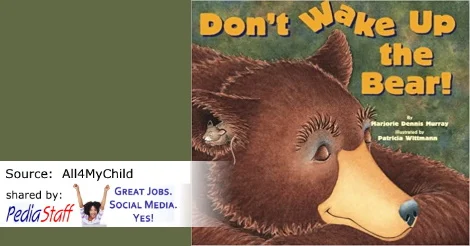SLP Corner: Book Review Through an SLP Lens – ‘Don’t Wake up the Bear’

[Source: All4MyChild]
This book review is reprinted here with the express permission of All4MyChild as it was originally posted on the All4MyChild Blog, December 12, 2011
Title: Don’t Wake up the Bear
Author: Majorie Dennis Murray
Review by: Meghan G. Graham M.S. CCC-SLP
Description: A sleeping bear becomes a warm, comfy place for many animals to keep warm in the cold. But this becomes a problem when a mouse with a cold wakes up the bear.
Goals/ objectives:
- negation and contractions (“don’t”)
- sequencing/ Retelling
- early prediction
- why
- animal vocabulary
- vocal volume
Why I like this story: A cute winter story.
Ideas for use:
- simple story sequence to retell. Can make board maker pictures or use google images to find the various animals. (hare, badger, fox, squirrel and mouse) and use to sequence and retell the story. Incorporate temporal markers (first, next, then, etc.)
- use to discuss setting (woods, cave). Draw a big winter wood scene and have child add the various winter animals to retell the story.
- have kids predict what animal is next? Can they think of another animal that lives in the woods? What might happen if they wake the bear?
- kids can add to the story with more winter animals and write their own stories
- Great for simple why questions. Why are they whispering? Why are they sleeping with the bear?
- lots of repetition of “don’t” if practicing or exposing to negation or contractions
- could use for voice volume. Lots of examples of whispering (when bears sleeping) vs. yelling (when bear wakes up). Could tie to the The Incredible 5 Point Scale and use for vocal volume.
Please support our contributors and visit All4MyChild’s blog and website
PediaStaff is Hiring!
All JobsPediaStaff hires pediatric and school-based professionals nationwide for contract assignments of 2 to 12 months. We also help clinics, hospitals, schools, and home health agencies to find and hire these professionals directly. We work with Speech-Language Pathologists, Occupational and Physical Therapists, School Psychologists, and others in pediatric therapy and education.
